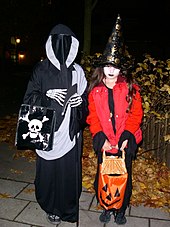Easter has been called a moveable feast because it doesn't fall on a set date every year, as most holidays do. Instead, Christian churches in the West celebrate Easter on the first Sunday following the full moon after the vernal equinox on March 21. Therefore, Easter is observed anywhere between March 22 and April 25 every year.
Easter Sunday is the culmination of Holy Week. Easter commemorates the resurrection of Jesus Christ. It is the most important Christian festival, and the one celebrated with the
greatest joy. The date of Easter changes each year, and several other Christian festivals fix their dates by reference to Easter. Churches are filled with flowers, and there are special hymns and songs. But not all Easter customs are Christian; some, such as the Easter Bunny, are pagan in origin.
The exact origins of this religious feast day's name are unknown. Some
sources claim the word Easter is derived from Eostre, a Teutonic goddess
of spring and fertility. Other accounts trace Easter to the Latin term "hebdomada alba", or white week, an ancient reference to Easter week and
the white clothing donned by people who were baptized during that time.
Through a translation error, the term later appeared as "esostarum" in Old
High German, which eventually became Easter in English.
In Spanish,
Easter is known as Pascua; in French, Paques. These words are derived
from the Greek and Latin Pascha or Pasch, for Passover.
Jesus' crucifixion and resurrection occurred after he went to Jerusalem
to celebrate Passover (or Pesach in Hebrew), the Jewish festival
commemorating the ancient Israelites' exodus from slavery in Egypt.
Pascha eventually came to mean Easter.
Easter Bunny
The Bible makes no mention of a long-eared, short-tailed creature who delivers decorated eggs to well-behaved children on Easter
Sunday; nevertheless, the Easter bunny has become a prominent symbol of
Christianity's most important holiday. The exact origins of this
mythical mammal are unclear, but rabbits, known to be prolific
procreators, are an ancient symbol of fertility and new life.
According
to some sources, the Easter bunny first arrived in America in the 1700s
with German immigrants who settled in Pennsylvania
and transported their tradition of an egg-laying hare called
"Osterhase" or "Oschter Haws." Their children made nests in which this
creature could lay its colored eggs. Eventually, the custom spread
across the U.S. and the fabled rabbit's Easter morning deliveries
expanded to include chocolate and other types of candy and gifts, while
decorated baskets replaced nests. Additionally, children often left out
carrots for the bunny in case he got hungry from all his hopping.
Easter Eggs
Easter
is a religious holiday, but some of its customs, such as Easter eggs,
are likely linked to pagan traditions. The egg, an ancient symbol of new
life, has been associated with pagan festivals celebrating spring. From
a Christian perspective, Easter eggs are said to represent Jesus'
emergence from the tomb and resurrection. Decorating eggs for Easter is a
tradition that dates back to at least the 13th century. Easter egg hunts and egg rolling are two popular egg-related traditions. In the U.S., the White House
Easter Egg Roll, a race in which children push decorated, hard-boiled
eggs across the White House lawn, is an annual event held the Monday
after Easter.
Easter Candy
Easter is the second best-selling candy holiday in America, after Halloween.
Among the most popular sweet treats associated with this day are
chocolate eggs, which date back to early 19th century Europe. Eggs have
long been associated with Easter as a symbol of new life and Jesus'
resurrection.











.jpg)






























